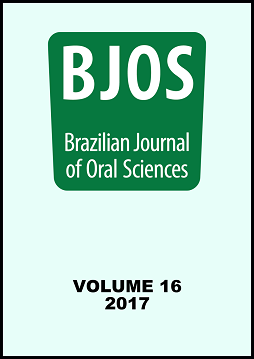Abstract
The objective of this study was to evaluate the mechanical properties of two bis-acryl interim resin materials, such as color stability, flexural strength and shear bond strength to flowable composite resin, simulating clinical situations when this material has to be used for repair as add-on. Two shades of two bis-acryl interim resin materials [Structur 2 SC (shades Bleach and A2); Protemp 4 (shades A1 and A2)] were evaluated. Discs (5 x 1 mm) were fabricated and baseline color was determined after 1 h. Ten specimens were immersed at 37oC in solutions of distilled water (control) and cola-based soft drink (Coca-Cola). Color measurements were performed with a spectrophotometer using CIELab parameters. Color readings were again measured after 2 hours, 4 hours, 24 hours and 7 days. Flexural strength was determined using the three-point bending test (10 x 1 x 2 mm) on a universal testing machine (0.5 mm/min) (n = 10). Discs of bis-acryl resin were embedded in acrylic resin, planned and distributed in 2 groups: G1 - Filtek Z350 Flow/Protemp4 and G2 - Grandio SO Flow/Structure 3 (n = 15). Cylinders (3.5 x 2 mm) were made with the flowable composite resins and polymerized for 20 s. The specimens were stored in distilled water at 37oC for 24 h and subjected to shear bond strength test. Data were analyzed using one-way ANOVA and Tukey’s test ( = 0.05). ΔE values were higher for Structur Bleach (3.08)a compared with Protemp 4 (shade A1, 2.22)b (shade A2, 2.25)b. There were no significant differences between Structur Bleach and Structur A2 (2.62)ab. Coca-Cola presented higher ΔE values (3.08)a than (2.00)b. Regarding time, ΔE values increased from 1.84a after 2 h to 2.31b after 4 h. The higher values were observed after 24 h and 7 days (2.93c and 3.09d, respectively). No significant differences were observed for the flexural strength of Structur (22.05 MPa)a and Protemp 4 (19.01 MPa)a. The repairs executed with Structur/Grandio flow (9.21 MPa)a were similar to those performed with Protemp 4/Z350XT flow (10.71 MPa)a. It can be concluded that the two bis-acyl resins evaluated showed similar physical and mechanical properties.The Brazilian Journal of Oral Sciences uses the Creative Commons license (CC), thus preserving the integrity of the articles in an open access environment.
Downloads
Download data is not yet available.

